Pittsburgh Left Has No Right
Pittsburgh Left Has No Right
April 2018
Worked as a designer and a researcher, to identify potential problems with "Pittsburgh left", run codesign sessions to gather solutions from non-designer people, and recommend social media as a tool to help solve this social problem.
Task
- Identify a problem local to Pittsburgh
- Conduct background researches to identify existing efforts
- Host two co-design sessions with local enthusiasts to contribute
- Design for a solution based on the feedback
- Present and deliver the final design artifacts to the local enthusiasts
What I did
- Brainstormed ideas for Pittsburgh local problems
- Visited local organizations for overviews on the problems
- Recruited participants
- Hosted co-design sessions
- Set up social media channels
- Designed posters/banners
- Presented the final solutions
- Worked on the process book
Challenges
- Technical solutions can cost a lot and is hard to maintain
- Our first problem identified (make local policies easier to understand) was too broad and had been a long time issue, so it is beyond the scope of this project
- "Pittsburgh Left" was a result of poorly-designed streets, which are hard to fix.
What I learned
- If it is a social problem, maybe we should seek for "social" ways to solve it.
- When everyone is given their chance to speak or to express, the discussion becomes more diverse.
- Some people think by speaking, some people think by drawing.
In this assignment of Interaction Design Studio, the students were supposed to identify and design for a Pittsburgh local problem. The idea is to settle the initiatives, and hand it to local representatives / stakeholders, who will carry on and move towards the problem. I worked with two other Master HCI students in this assignment.
First Target
We first brainstormed more than 20 different local problems, including "road rage", "snow removal", "slowing down before tunnels", "invasive species tracker", many of which are considered to be unique to Pittsburgh.
We ended up selecting the communication between local communities and government, who often times uses jargons to be accurate with their official documents, but meanwhile preventing civilians from understanding. We anticipated that such gaps can be bridged by introducing people to concepts with in a more engaging way, such as videos, posters. We can also educate and develop tools to help local policy makers to better communicate their thoughts.
Under this topic, our participants for the codesign sessions could include community outreach, city planners, local government representatives, and community members.
Inspired by our social design concept, we next sought to vet our own understanding and assumptions of the problem space with residents and business owners in Bloomfield. Our first stop was a nonprofit press, Creative Nonfiction where we were able to speak with Nichole Faina, a coordinating editor very familiar with our topic.
She guided us away from tackling something so complicated and personal for so many as the timeline of this project just inherently made this issue out of reach for us. She also brought up some interesting points around prior and ongoing work in this area, local community activists, projects, and ways to engage. We knew we might need a different direction.
Another Target
After talking it over amongst ourselves, we drew from personal experience around pedestrian safety. As frequent pedestrians, we’ve noticed that Pittsburgh drivers aren’t always the most courteous or even safe when it comes to sharing the road. While bad driving is pretty broad and not a great topic for this project, there is one thing that is unique to Pittsburgh and does actually make road safety that much more challenging. That thing is the Pittsburgh left.
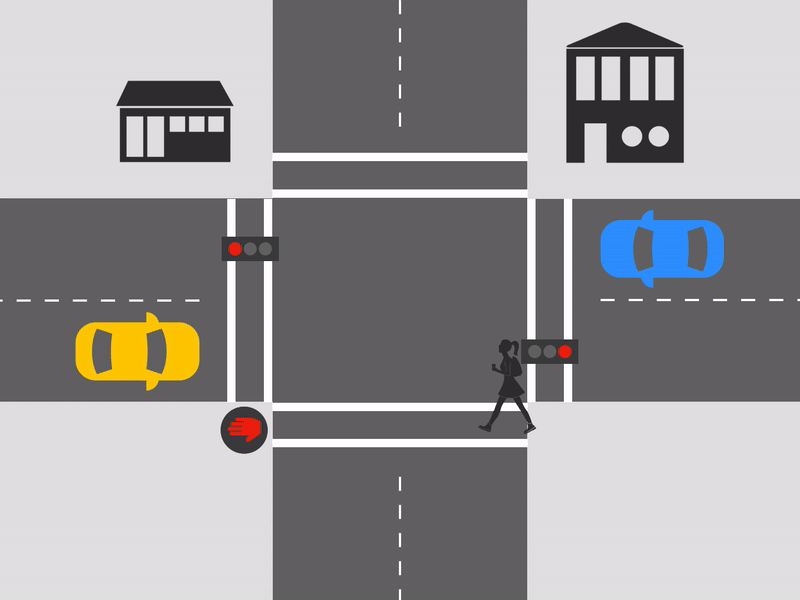
The animation we made to address the impact of Pittsburgh left on Pedestrian Safety. Later on, this animation was uploaded onto Wikipedia under the article Pittsburgh left
Author: Ross Rybalov. Licensed under CC-by-SA 4.0.
With our new focus, we then started recruiting participants using reddit (people complain about Pittsburgh left on reddit) and our personal network. We managed to recruit 6 participants, all having different roles (drivers, cyclers, or pedestrians), and split them into two different codesign session.
Design Sessions
In the first session, our participants were gravitating towards a technical solution with sensors, however the issue of cost and community engagement kept coming up over and over again. Painting something on the road seemed to be the consensus but only because of feasibility - it was not something everyone was really excited about. We also realized some of the best discussion was about the social issues of the turn and how people approached thinking about who had the most ability to affect change.
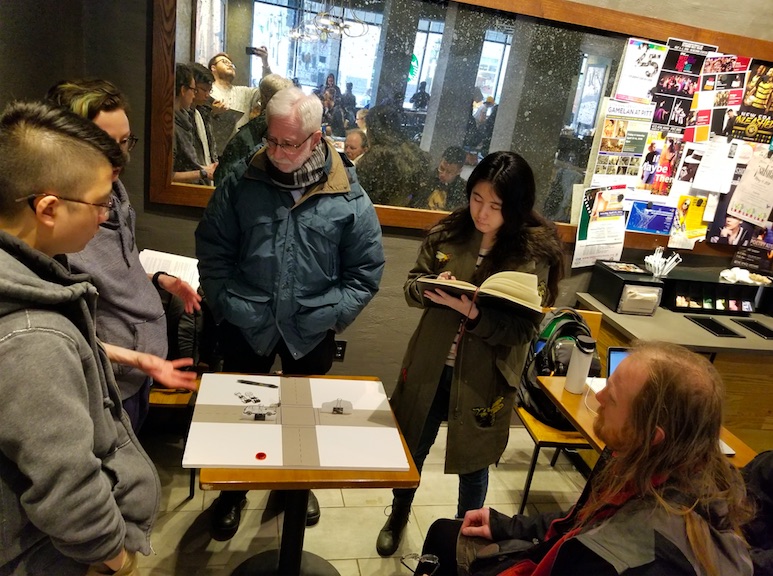
In the codesign session, our participants were contributing, while I (to the right of the table) was taking notes.
The second session started out outside to help set the scene better, however moved indoors due to the cold weather. This group was much more open to brainstorming and sketching their ideas so we were able to stick to our original plan better. Although initially the solutions were trending in the same direction as the other session (something technical like sensors), the conversation shifted towards a social solution and facilitating a campaign to raise awareness about the problem.
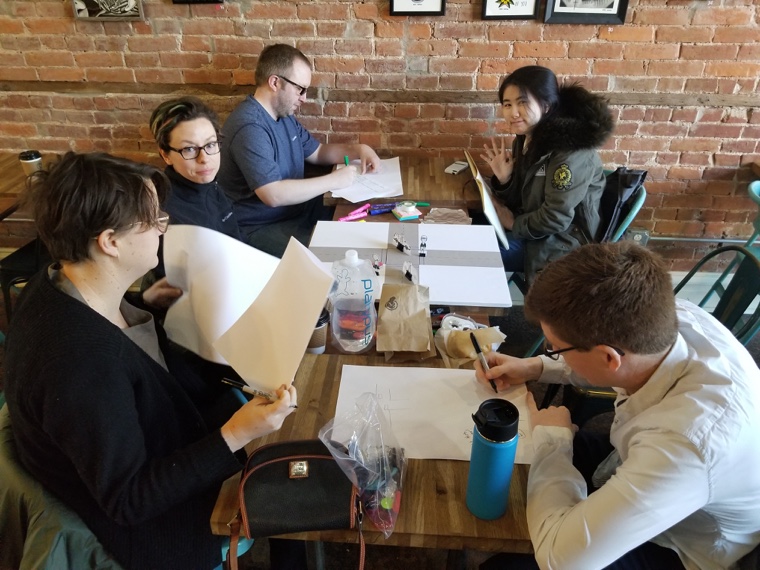
The participants sat down and drew their solutions on the paper.
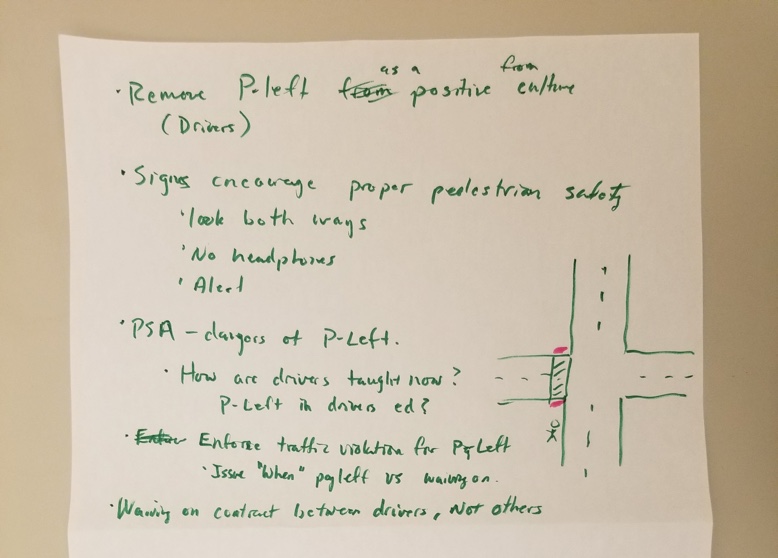
A solution our participants came up.
Solution
We came back together as a team and thought back to the parameters of the project - how could we facilitate a social change, possibly with PSA, through a self-generating and self-maintaining social solution that would still be aimed at raising awareness about the dangers of the Pittsburgh left.
After a couple rounds of some additional ideation, we settled on creating a publicly accessible repository for people to send their photos and videos that shows how nefarious the Pittsburgh left can be. Although our participants didn’t explicitly mention posting videos of actual incidents, they did keep going back putting a mirror up to the people committing the infractions and how that would be a useful tool to make them stop and think. We felt that this tactic would be much more effective than a PSA that would have to be made by a single group and is inherently not self-sustaining.
We set up YouTube channels and twitter accounts about Pittsburgh left. We also made posters to advertise the social media platform to increase people's awareness. We may also designate moderators for these channels (in this case, they would be our design session participants who were passionate about the Pittsburgh left issue).
The video we uploaded to our YouTube Channel Pittsburgh Left.
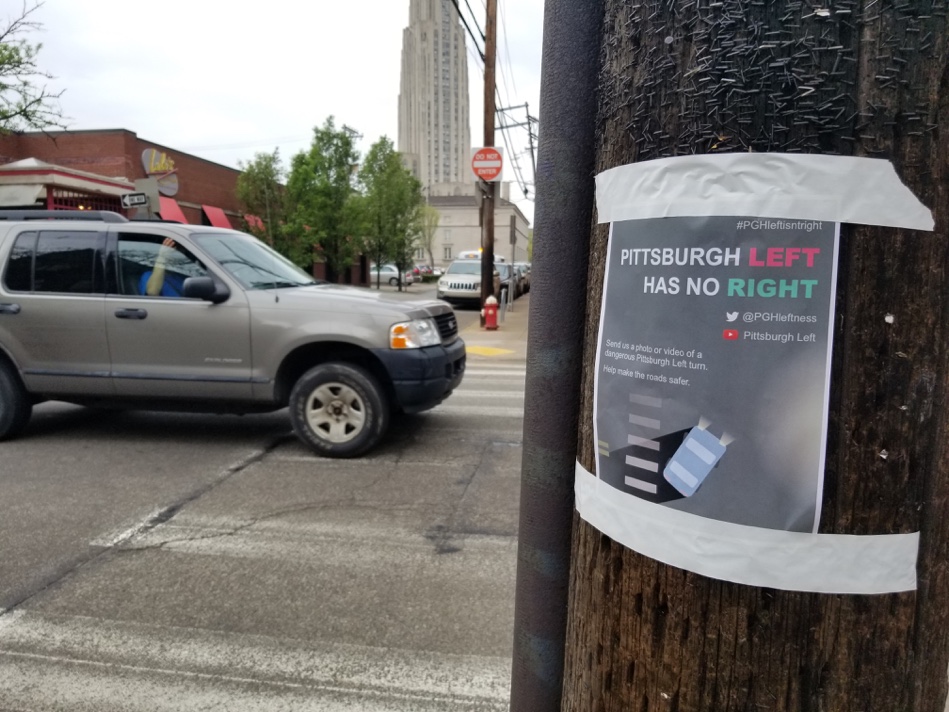
Spread the posters.
In the Future
In soliciting photos and video from the Pittsburgh pedestrian community, we’re enabling a grassroots effort to create an understanding of the issue and just how common it is. Should this system facilitate the collection of enough data, it could also motivate local media and policymakers to take action in favor of investment in enforcement and infrastructure updates to make intersections safer for everyone. Viewers can send this campaign around to city council, and neighborhood and community organizations - to the places they want to see the difference embodied.
In the near future, the moderators will need to do most of the work involved with creating an online community. Should the community never take off, even having a place for videos and images to be stored for reference would help this issue immensely. If the community does take off, it’s possible that it could inspire safer driving, more alert pedestrians, and eventually perhaps a local cultural shift away from the acceptance of this custom to a more pedestrian friendly adherence to state law.
Check out more
IoT Water Bottle
A mirror to facial blemishes due to dehydration, and a bottle which reminds people to drink based on the mirror's evaluation.